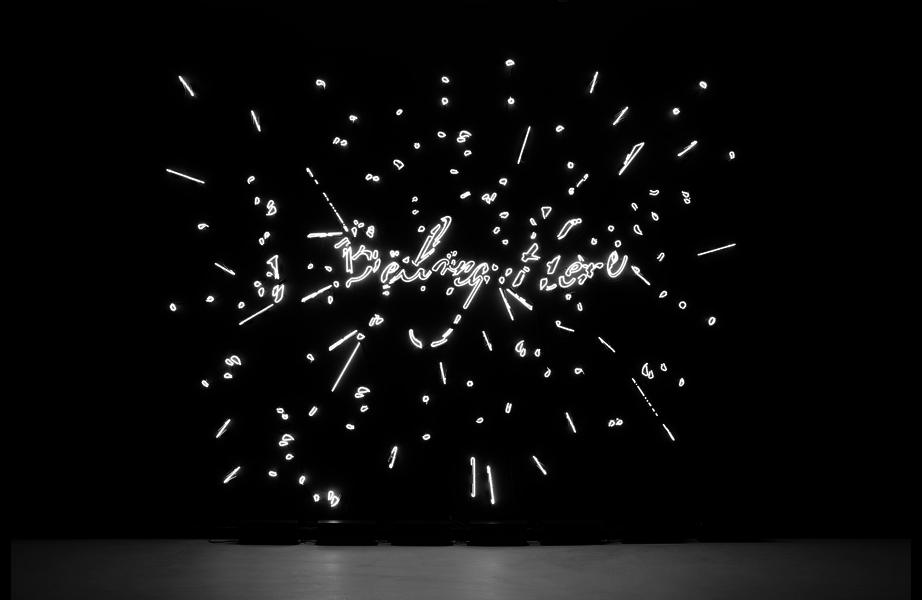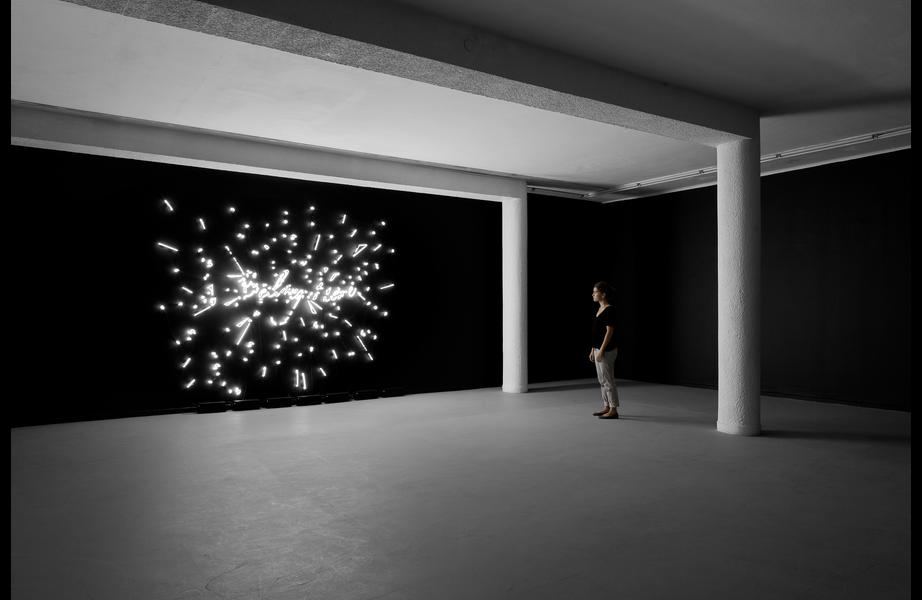Tavares Strachan : I Belong Here
2011
“Installed in the closed viewing space of an institutional black box, a single sentence hovers in the center of a wall-sized field of glowing white fragments: 'I Belong Here.' Tavares Strachan’s 2011 neon sculpture, comprised of tens of feet of convoluted glass tubing mounted on a 210 x 320 cm black…
“Installed in the closed viewing space of an institutional black box, a single sentence hovers in the center of a wall-sized field of glowing white fragments: 'I Belong Here.' Tavares Strachan’s 2011 neon sculpture, comprised of tens of feet of convoluted glass tubing mounted on a 210 x 320 cm black square is a still, sculptural object. When turned on, the neon tubes flicker and buzz; the work emits a pale light and an audible hum. Electricity makes the sculpture visible, revealing the way in which glass, power, black paint, and noble gases combine to create a drawing in space, an industrially produced object (glass must be fabricated, neon distilled from air) crafted to emulate a hasty, almost indecipherable scrawl within a field of gestural lines. The words seem to emerge from—or disintegrate back into—the vibrating constellation that surrounds them. Once comprehension is earned, questions of intelligibility are quickly followed by those of semantics. Who is the “I”? The artist, the viewer, the text itself? And where is “here”? An artist’s studio, a collector’s home, an institutional black box, a reproduction in this book? The sentence evokes presence itself.
…
More critically, the “I” in “I Belong Here” is a subject wholly constituted through the act of translation. An artist hailing from an island nation located well outside the possible “here” of the centers of contemporary art discourse and production, only begins to exist within those realms when he or she speaks through them, appropriating their language and forms. As a practice, translation begins as a matter of intercultural communication: an expressing of information (thoughts, needs, desires) across borders. But, as Conceptualism historically emphasized, language itself inevitably involves questions of power relations and forms of domination. There is significant slippage here, however, in negotiating the meaning and terrains of agency, of both the work in question and the wider discursive realm in which it operates. Power is never merely a one-way flow from margin to center, and models of mimesis—models that structure Strachan’s practice—have historically held rich potential for subversion.”1
All three words in the sentence are individually as well as collectively charged with the polemics of identity, of locus and of presence. Invariably meanings will shift according to the viewer – every single person will have a unique explanation. While the legibility of the text carries an existential concern of Strachan’s, its presentation as in a state of explosion hearkens to his interest in the science of orthostatics. When confronted with extreme pressures or forces, an organism will respond dramatically. The violent reaction is analogous to the sharp and irreversible powers of detonation. Inarguably one of the most iconic works by Tavares Strachan, I Belong Here conflates all the conceptual threads that energize his art and funnels them into an impeccably executed installation.
1 Texts extracted from “Found in Translation” by Stamatina Gregory, independent curator and critic based in New York, in I Belong Here, published by Conceptio ART in Bangkok, 2013.
[read full article]


